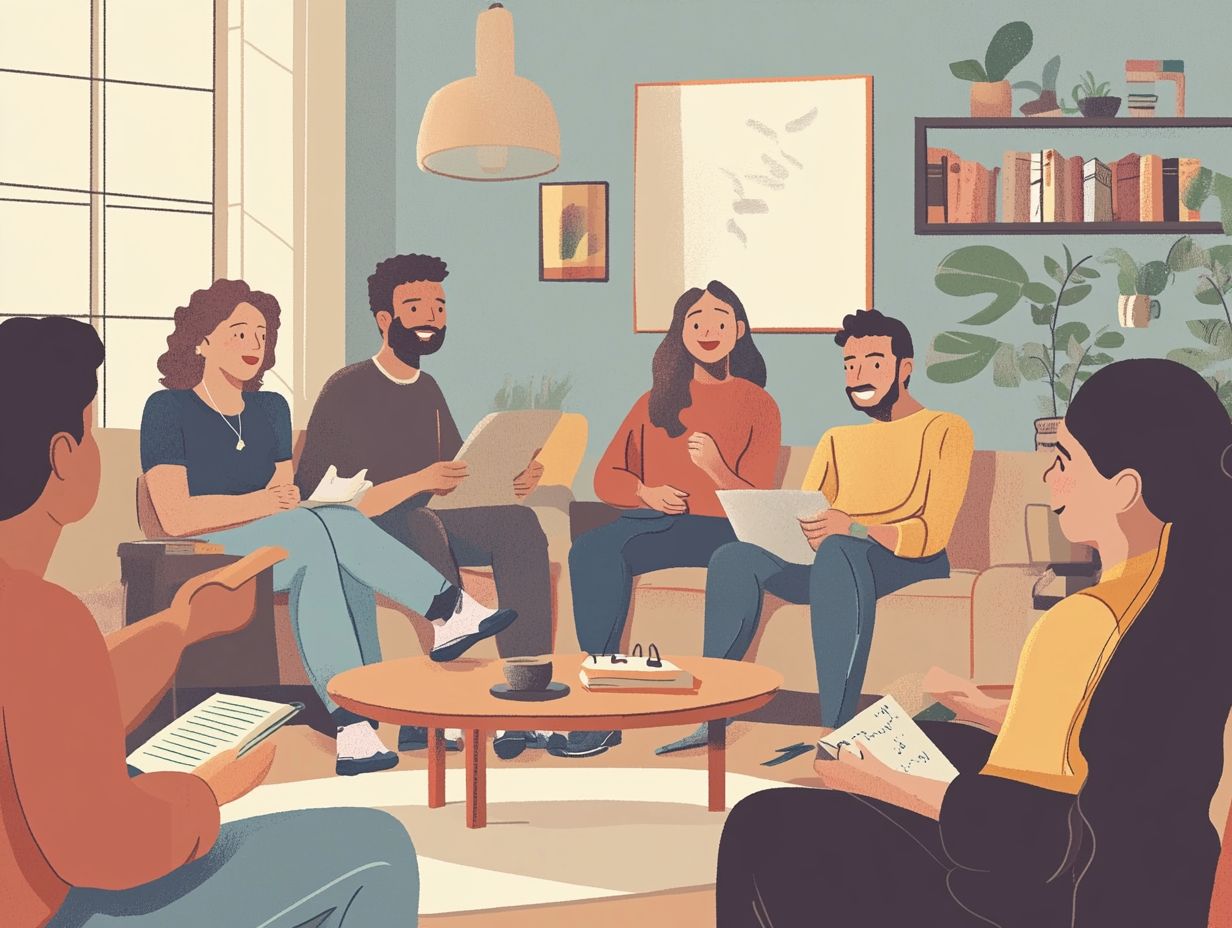How to Use Movies for Language Learning
Movies have always been a great source of entertainment. They also offer remarkable opportunities for language learning.
By immersing yourself in captivating stories, you can enhance your listening and comprehension skills, expand your vocabulary, and uncover idiomatic expressions within their natural context.
Selecting the right films and incorporating them into your language lessons can turn your learning experience into something truly enriching.
This article explores practical strategies, tips, and techniques that will help you maximize your language acquisition through the exciting world of cinema.
Contents
- Key Takeaways:
- Why Movies are Great for Learning Languages
- Choosing the Right Movies for Language Learning
- Incorporating Movies into Language Learning Lessons
- Supplementing Movie Learning with Other Resources
- Tips for Maximizing Language Learning through Movies
- Frequently Asked Questions
- What are the benefits of using movies for language learning?
- How can I use movies for vocabulary building?
- What is the best way to improve my speaking skills through movies?
- How can I make sure I understand the movie’s plot and dialogue in a foreign language?
- What are some tips for choosing the right movies for language learning?
- Is it helpful to watch the same movie multiple times for language learning?
Key Takeaways:

- Watching movies in a target language improves listening and comprehension skills.
- Choose films that match your language level and genre preferences.
- Incorporate movie-based activities and resources into your lessons for effective learning.
Why Movies are Great for Learning Languages
Using movies for language learning presents many advantages beyond traditional study techniques. Engaging with a target language through visual storytelling can greatly enrich your vocabulary, grammar, and cultural insights.
Whether you prefer captivating children s movies on Netflix or thought-provoking foreign films on Amazon, the immersive experience of watching written stories or reality TV allows you to develop language skills naturally.
This method not only makes learning enjoyable but also helps you grasp high-frequency words and phrases in context, leading to a better understanding of the language.
Improving Listening and Comprehension Skills
Enhancing your listening and comprehension skills is vital for mastering a new language, and foreign films provide an excellent platform for developing these abilities while enjoying an immersive cinematic experience.
These films expose you to native pronunciations, a variety of accents, and colloquial expressions that you won’t find in textbooks. Engaging with different cultural contexts gives you deeper insight into how language is used in real life.
One effective technique is segment watching. Pause the film to practice challenging phrases or mimic the actors pronunciation. This method reinforces your learning and builds your confidence in speaking.
Diving into various genres from gripping dramas to lighthearted comedies offers a richer immersion experience. It reveals how context shapes dialogue, humor, and emotional expression.
Expanding Vocabulary and Idiomatic Expressions
Growing your vocabulary and understanding idiomatic expressions is essential for mastering a language, and movies provide a wealth of high-frequency words in a natural setting.
As you explore various film genres, you’ll encounter authentic dialogues that introduce new vocabulary while conveying cultural nuances. Scripted shows often depict everyday scenarios, showcasing idiomatic expressions that aid both understanding and retention. Meanwhile, children s movies present vocabulary through simple, relatable stories, making complex concepts accessible for younger audiences or beginners.
This diverse range of genres allows learners at different proficiency levels to engage with the language in a meaningful way, facilitating a deeper understanding of nuances often overlooked in traditional learning environments.
Choosing the Right Movies for Language Learning
Picking the right movies for language learning can greatly impact your journey toward mastering a new language. It s vital to select films that not only align with your language level but also resonate with your personal interests.
This thoughtful approach enhances your engagement and retention, making the learning experience enjoyable and effective.
Start your language learning journey today by exploring new films!
Considerations for Language Level and Genre

When selecting movies for language learning, it’s crucial to consider your current language level and the genre of the films to create an effective learning experience.
Different genres cater to various language skills, allowing you to find an appropriate starting point. For example, children’s movies often feature simple dialogue and clear visuals, making them accessible for beginners eager to grasp foundational vocabulary. In contrast, foreign films may incorporate nuanced language and cultural references, presenting a more intricate experience ideal for advanced learners seeking a challenge.
Ultimately, aligning your movie choices with your personal interests not only enhances your understanding but also keeps your motivation soaring, ensuring that the learning process remains enjoyable and engaging.
Incorporating Movies into Language Learning Lessons
Incorporating movies into your language learning lessons can supercharge your learning experience. By introducing engaging activities and techniques, you foster an environment that encourages active participation and meaningful practice.
This approach not only makes learning enjoyable but also enriches your understanding of the language in context.
Activities and Techniques for Effective Learning
Utilizing a variety of activities and techniques can transform your movie-watching experience into a dynamic language-learning journey. This allows you to engage actively with the content while sharpening your skills.
By incorporating note-taking for key vocabulary and phrases, you can deepen your understanding of the language in context. You can practice pronunciation by repeating memorable dialogues, which enhances both your speaking abilities and confidence.
Engaging in discussions about the cultural themes and social issues presented in the films can further enrich your appreciation of the language and its nuances. Adjusting audio settings and selecting subtitles tailored to your learning needs makes the experience more accessible and personalized, ensuring you reap maximum benefits from this enjoyable method of language acquisition.
Supplementing Movie Learning with Other Resources
Supplementing your movie learning with diverse resources can greatly elevate your language acquisition journey. By incorporating additional tools, you bolster your comprehension and enhance the practical application of your skills.
Using Subtitles and Transcripts
Utilizing subtitles and transcripts while watching movies can significantly enhance your language learning experience. This bridges the gap between spoken and written language, thereby reinforcing your vocabulary and reading skills.
These tools encourage you to make connections between the sounds you hear and the text you see, fostering a deeper understanding of the language. This approach not only aids in memory retention but also boosts your confidence in pronunciation and comprehension.
For optimal results, it’s advantageous to begin with subtitles in your target language, allowing you to fully immerse yourself in the sound patterns and phrasing. Once you feel more comfortable, consider switching to subtitles in your native language to clarify any nuances.
As you enjoy movies or shows, take a moment to pause and thoroughly read each subtitle. This practice can further enhance your vocabulary and comprehension skills.
Imagine diving into a world of vibrant characters while effortlessly picking up new words! Start incorporating movies into your language learning journey today!
Practicing Conversation and Pronunciation

Practicing conversation and pronunciation is a crucial part of your language learning journey. Foreign movies can be exceptional tools for mimicking native speakers and improving your fluency.
Choose engaging scenes from these films to dive into shadowing techniques. This means repeating lines right after you hear them. This approach lets you capture not just the words but also the intonation and rhythm.
Role-playing exercises offer a powerful way to recreate the emotional context of conversations. You can embody different characters while improving your speech. Exposure to a variety of accents and dialects through diverse movie selections sharpens your listening skills.
The emphasis on repetition in these practices solidifies your language foundation. This fosters greater confidence and proficiency as you progress.
Tips for Maximizing Language Learning through Movies
To truly maximize your language learning through films, adopt a thoughtful strategy. Begin by crafting a structured learning plan that includes various film genres and themes.
This approach enhances your engagement and boosts your motivation. It makes the learning experience both enjoyable and effective.
Creating a Structured Learning Plan
Creating a structured learning plan tailored to your language goals can greatly enhance your efficiency and effectiveness when using movies. This method blends educational elements with entertainment.
By setting clear and achievable objectives, you can focus on specific skills. Whether expanding your vocabulary or grasping conversational nuances, choose films that resonate with your interests.
Regularly scheduled practice sessions cultivate consistency. This reinforces the knowledge you’ve gained.
Tracking your progress and adapting your plan is vital for sustaining motivation. This strategy promotes steady improvement and deepens your connection with the language you re learning.
Staying Engaged and Motivated
Stay engaged and motivated! It s key to making your language learning journey exciting. Incorporating foreign films can transform your experience into something enjoyable and culturally enriching.
By exploring various genres, you ll discover a broad vocabulary and diverse cultural expressions. Set individual challenges, like watching a specific number of films each month, to foster a sense of accomplishment.
Diving into different cultural themes enhances your understanding and appreciation of the language itself. Celebrate milestones, whether completing a challenging film or using new vocabulary in conversations.
Surround yourself with a supportive community to share achievements and inspire each other throughout this rewarding journey.
Frequently Asked Questions
What are the benefits of using movies for language learning?

Movies make learning a new language fun! They show you real conversations and help develop your listening skills.
How can I use movies for vocabulary building?
Choose movies set in a specific country or region where the language is spoken. This allows you to learn vocabulary related to that culture, such as food, customs, and everyday expressions.
What is the best way to improve my speaking skills through movies?
Watch the movie with subtitles in your target language. Try to mimic how the actors sound and speak.
How can I make sure I understand the movie’s plot and dialogue in a foreign language?
Start by watching the movie with subtitles in your native language. Gradually switch to subtitles in the target language to understand the dialogue better.
What are some tips for choosing the right movies for language learning?
Choose movies you already know. This makes it easier to follow along and grasp the dialogue.
Is it helpful to watch the same movie multiple times for language learning?
Absolutely! Repeating the same movie opens the door to new words and phrases, making your language skills stronger!




